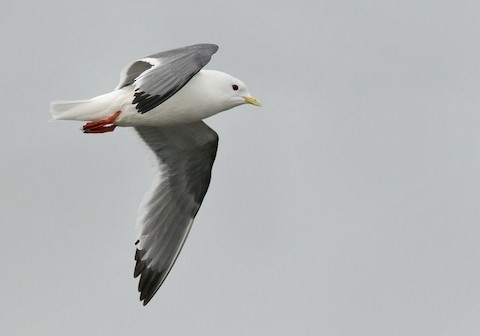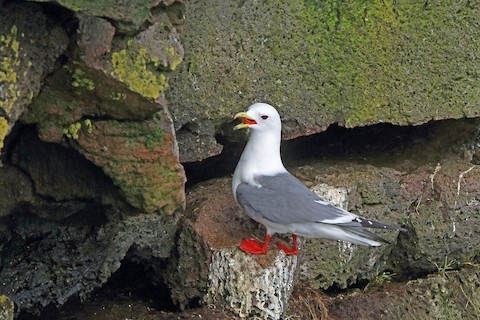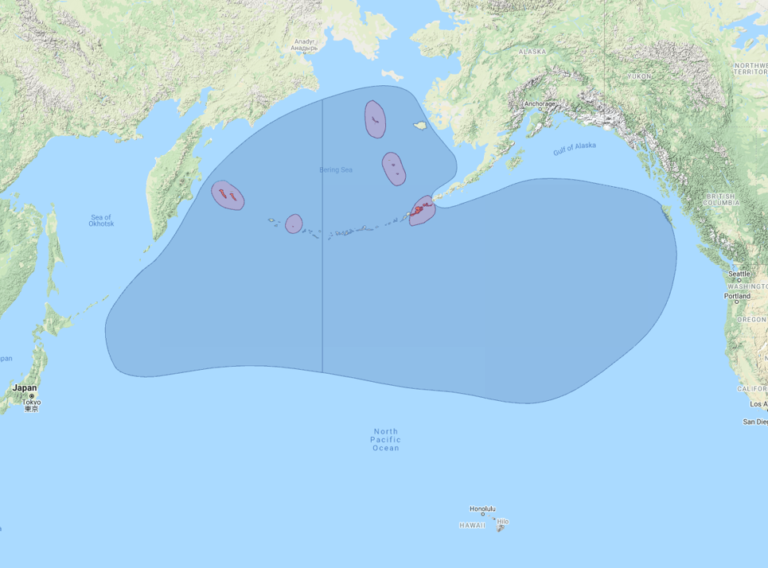Birdfinding.info ⇒ Locally common in its remote Beringean range. The most accessible place where it can be found reliably is St. Paul Island, where it occurs year-round. Also present, but less reliable, year-round in waters around Dutch Harbor. From fall to spring, it is rare but regular in waters along the Alaska Peninsula and east to offshore waters south of the Kenai Peninsula. In Japan, there have been many records, often flocks, of juveniles in waters around Hokkaido from September to November.
Red-legged Kittiwake
Rissa brevirostris
Breeds on islands of the Bering Sea and disperses locally and into the North Pacific Ocean.
Breeding. Breeds from May to September in colonies on cliff ledges in the Pribilof, Commander, Aleutian, and St. Matthew Islands.
About 80% of the world population nests in the Pribilofs, with about 120,000 pairs on St. George, 700 on St. Paul, and 90 on Otter.
The Commander Islands—Arij Kamen, Toporkov, Bering, and Mednyi—together support about 16,000 pairs, with the vast majority on Bering Island.
In the Aleutians: Buldir and adjacent islets support about 4,300 pairs; Bogoslof and nearby Fire Island have about 450 pairs; and there are small outpost colonies (<10 pairs each) known from Amak, Unalga, Koniuji and Chagulak Islands.
St. Matthew supports colonies that seem likely to number in the hundreds of pairs, but as of 2021 apparently had not been thoroughly surveyed.
Nonbreeding. Disperses throughout the Bering Sea, mostly to the northern and western portions, according to geolocator tracking.
Smaller numbers winter along the Kurile Islands (and rarely to Hokkaido, mainly in fall), into the Sea of Okhotsk, in the North Pacific along the Aleutians, and sparingly east into the western and central Gulf Alaska.
Occasionally recorded as a vagrant along the western coast of North America from British Columbia to Oregon.
Exceptional vagrants have been recorded from: Forty Mile, Yukon Territory (October); Las Vegas, Nevada (July 3, 1977); Marin County, California (February 13, 2001); and Anaheim, California (February 28, 1996).
Identification
A small gull that strongly resembles its much more familiar and widespread relative, the Black-legged Kittiwake: both have all-yellow bills and evenly black wing-tips. On the spread wing, the black area can appear so crisply defined that it seems to have been dipped in ink.
Adult Red-legged differs most noticeably from Black-legged in having vivid, coral-red legs. Red-legged also has a much shorter bill, slightly darker gray mantle, and much darker underwings.
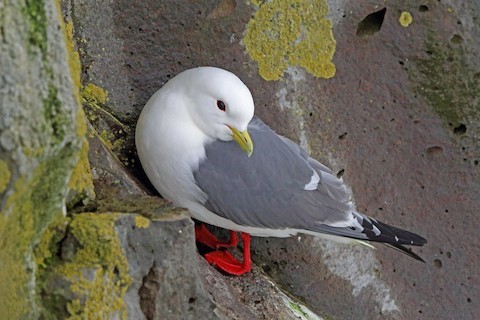
Red-legged Kittiwake. (St. Paul Island, Alaska; May 25, 2015.) © Nigel Voaden
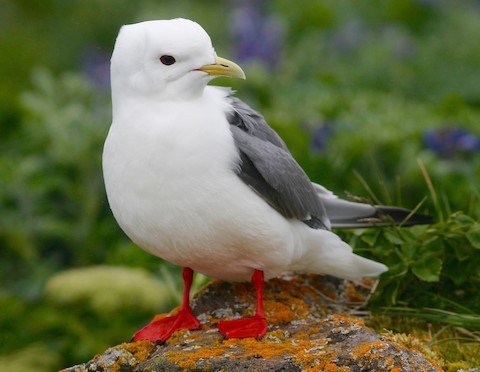
Red-legged Kittiwake. (St. Paul Island, Alaska; June 22, 2016.) © Stephan Lorenz

Red-legged Kittiwake. (St. Paul Island, Alaska; August 11, 2008.) © Scott Schuette
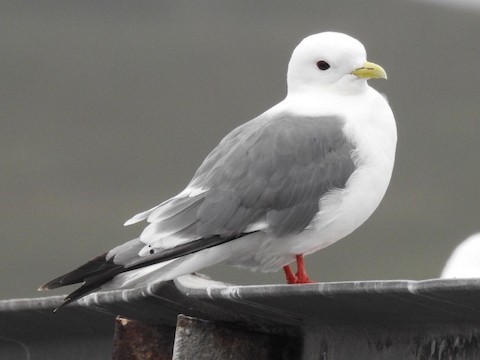
Red-legged Kittiwake. (St. Paul Island, Alaska; September 2, 2018.) © Cynthia Berg
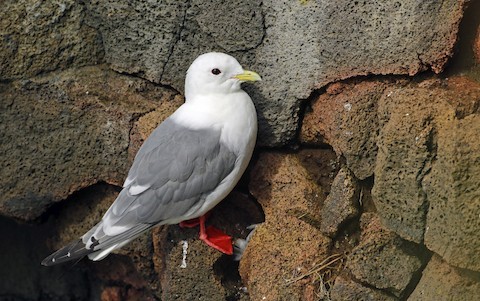
Red-legged Kittiwake. (St. Paul Island, Alaska; September 3, 2018.) © Luke Seitz
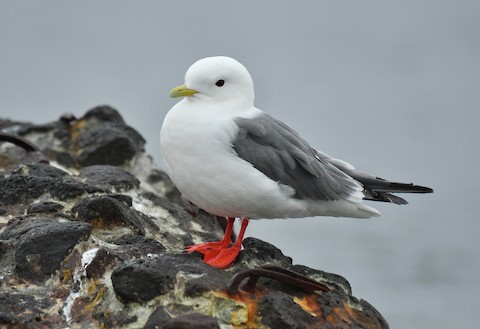
Red-legged Kittiwake. (St. Paul Island, Alaska; July 14, 2012.) © Ryan O’Donnell

Red-legged Kittiwake. (St. Paul Island, Alaska; September 17, 2018.) © Victor Stoll
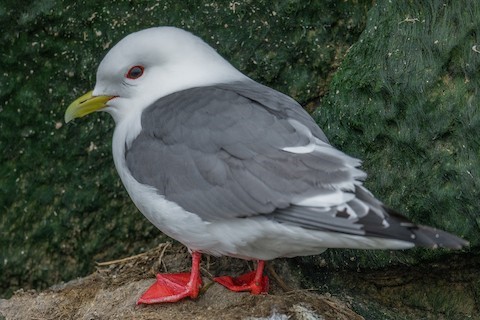
Red-legged Kittiwake. (Ari Karmen Rock, Commander Islands, Russia; June 29, 2017.) © Jeff Bleam
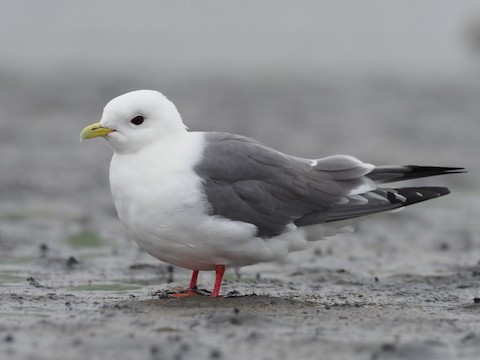
Red-legged Kittiwake. (St. Paul Island, Alaska; July 28, 2019.) © Stephan Lorenz

Red-legged Kittiwake. (St. Paul Island, Alaska; July 28, 2019.) © Stephan Lorenz

Red-legged Kittiwake. (St. Paul Island, Alaska; June 12, 2012.) © Ryan O’Donnell

Red-legged Kittiwake. (Kalsin Bay, Kodiak Island, Alaska; June 25, 2016.) © Richard MacIntosh

Red-legged Kittiwake. (Deep Bay, British Columbia; September 27, 2020.) © Mark Wynja
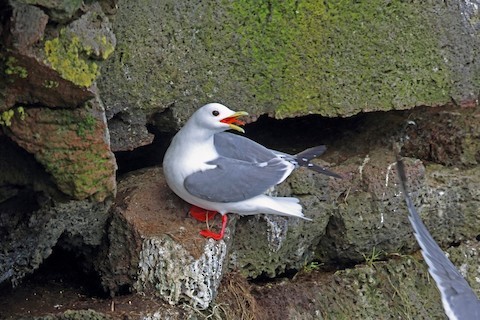
Red-legged Kittiwake, showing vividly coral-red tongue. (St. Paul Island, Alaska; May 24, 2015.) © Nigel Voaden
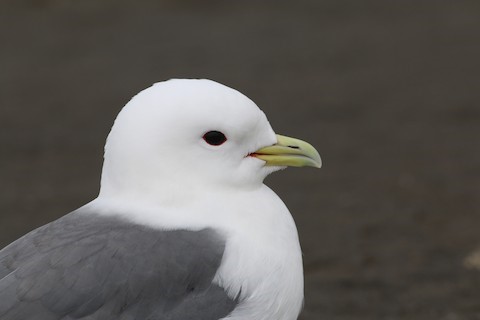
Red-legged Kittiwake. (St. Paul Island, Alaska; June 7, 2016.) © Scott Schuette

Red-legged Kittiwake. (St. Paul Island, Alaska; May 29, 2012.) © Ryan O’Donnell
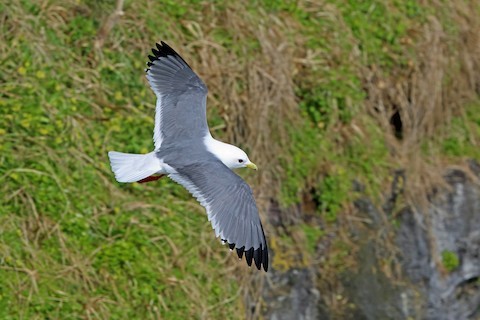
Red-legged Kittiwake. (St. Paul Island, Alaska; May 24, 2015.) © Nigel Voaden

Red-legged Kittiwake. (St. Paul Island, Alaska; May 24, 2015.) © Nigel Voaden

Red-legged Kittiwake. (St. Paul Island, Alaska; June 5, 2015.) © Eric VanderWerf
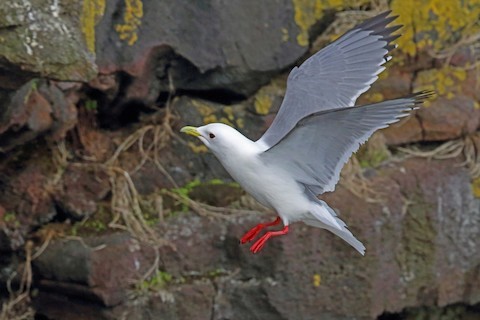
Red-legged Kittiwake. (St. Paul Island, Alaska; May 24, 2015.) © Nigel Voaden
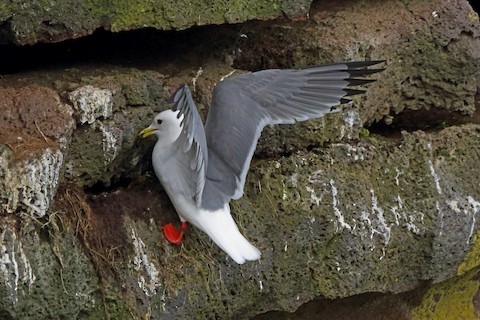
Red-legged Kittiwake. (St. Paul Island, Alaska; May 24, 2015.) © Nigel Voaden
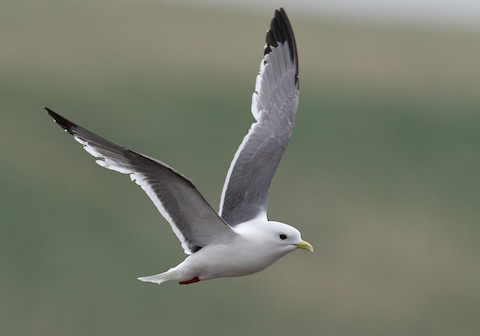
Red-legged Kittiwake. (St. Paul Island, Alaska; June 8, 2016.) © Lars Petersson
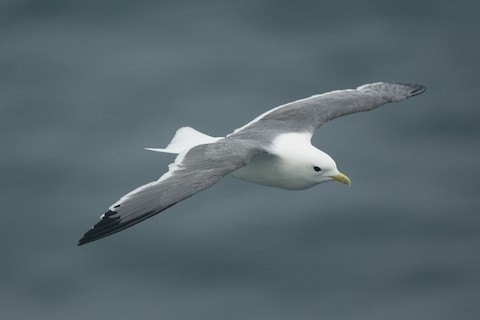
Red-legged Kittiwake. (St. Paul Island, Alaska; July 25, 2015.) © Cory Gregory
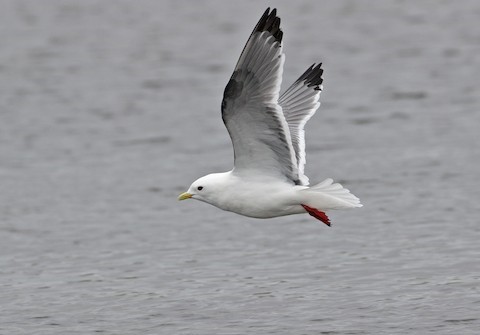
Red-legged Kittiwake. (St. Paul Island, Alaska; June 21, 2018.) © Sam Woods

Red-legged Kittiwake. (St. Paul Island, Alaska; July 28, 2019.) © Stephan Lorenz
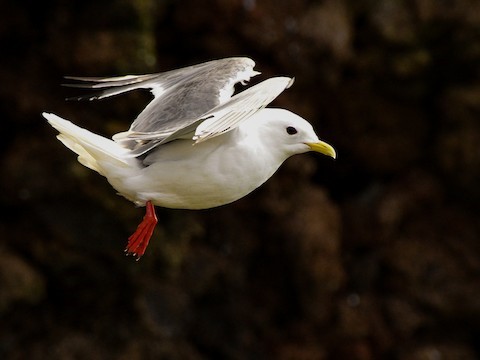
Red-legged Kittiwake. (St. Paul Island, Alaska; August 15, 2018.) © Kathie O’Neal

Red-legged Kittiwake. (St. Paul Island, Alaska; June 5, 2015.) © Eric VanderWerf

Red-legged Kittiwake. (St. Paul Island, Alaska; June 12, 2012.) © Ryan O’Donnell
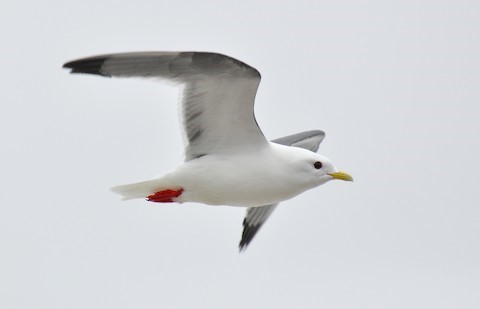
Red-legged Kittiwake. (St. Paul Island, Alaska; June 12, 2012.) © Ryan O’Donnell
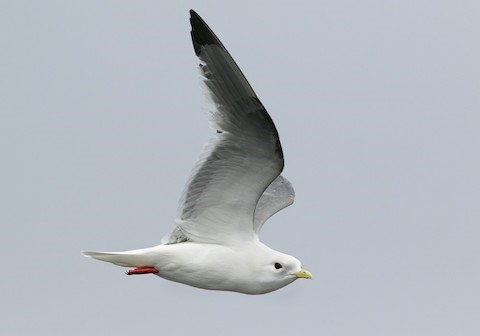
Red-legged Kittiwake. (St. Paul Island, Alaska; June 7, 2016.) © Lars Petersson

Red-legged Kittiwake. (St. Paul Island, Alaska; June 1, 2019.) © Doug Gochfeld
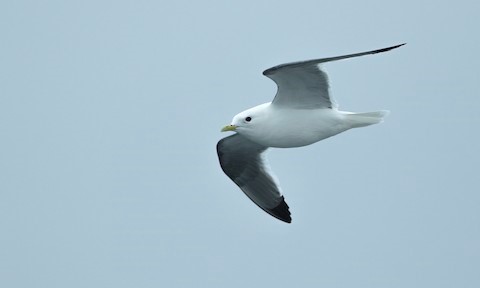
Red-legged Kittiwake. (Offshore west of St. Paul Island, Alaska; August 21, 2018.) © Zak Pohlen

Red-legged Kittiwake. (East of Shemya Island, Alaska; May 13, 2012.) © Isaac Helmericks

Red-legged Kittiwake. (St. Paul Island, Alaska; June 6, 2016.) © Lars Petersson
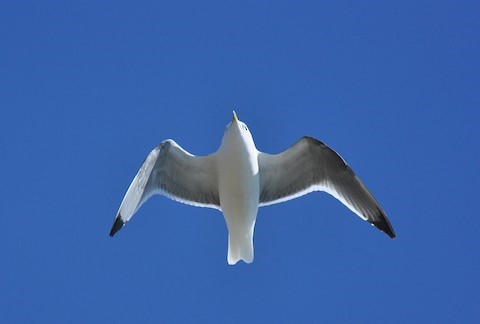
Red-legged Kittiwake. (St. Paul Island, Alaska; June 16, 2012.) © Ryan O’Donnell
Immature Plumages. Juveniles have black legs, a black auricular mark, a thin blackish partial collar, extensively black primaries, and a largely white wedge on the trailing edge of the wing. Unlike other small gulls, juveniles do not have a black tail tip.
Within a few months the legs turn pale, then pinkish, then red.
First-summer birds have essentially adult-like plumage, but usually retain the blackish auricular mark, have more extensive black on the outer primaries, and sometimes a dark tip on the mostly yellowish bill.

Red-legged Kittiwake, juvenile. (St. Paul Island, Alaska; September 11, 2019.) © Tammy McQuade
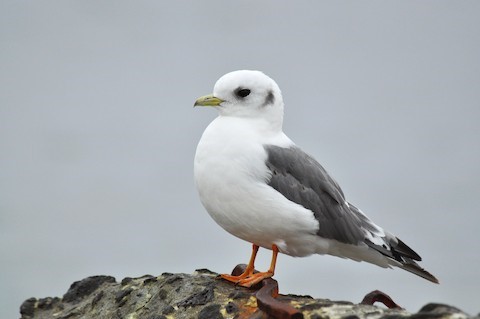
Red-legged Kittiwake, first-summer subadult. (St. Paul Island, Alaska; July 14, 2012.) © Ryan O’Donnell

Red-legged Kittiwake, juveniles. (Hamanaka, Hokkaido, Japan; September 26, 2020.) © Stuart Price

Red-legged Kittiwake, juvenile. (Hamanaka, Hokkaido, Japan; September 26, 2020.) © Stuart Price

Red-legged Kittiwake, juvenile. (St. Paul Island, Alaska; August 27, 2012.) © Ryan O’Donnell

Red-legged Kittiwake, juvenile. (Offshore from Kushiro, Hokkaido, Japan; October 13, 2010.) © Kouta Kurasawa
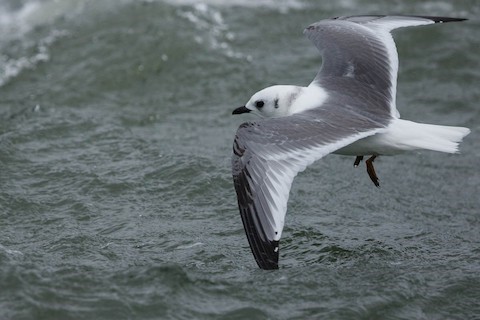
Red-legged Kittiwake, juvenile. (Hamanaka, Hokkaido, Japan; September 26, 2020.) © Stuart Price

Red-legged Kittiwake, juvenile. (St. Paul Island, Alaska; August 27, 2012.) © Ryan O’Donnell

Red-legged Kittiwake, first-summer subadult showing mostly juvenile-type plumage. (St. Paul Island, Alaska; June 6, 2016.) © Lars Petersson

Red-legged Kittiwake, first-summer subadult showing mostly juvenile-type plumage. (St. Paul Island, Alaska; June 6, 2016.) © Lars Petersson
Cf. Black-legged Kittiwake. Red-legged and Black-legged Kittiwakes are similar, closely related species, which occur together throughout Red-legged’s range. Adult leg color is the most obvious difference, but not always visible.
In flight, adult Red-legged can be distinguished at long range by its darker gray mantle and mostly gray undersides of the flight feathers—which are mostly white on Black-legged. Red-legged also has more extensive black on the leading edge of the primaries.
If only the head can be seen well, Red-legged can be distinguished by its much shorter bill and sometimes by the apparent size or shape of its head, which often appears disproportionately large, at least in comparison to its short bill.
Immature Red-legged differs from immature Black-legged in that it never shows a black tail tip and does not develop a full black “M” on the upperparts—on Red-legged, the black is always limited to the primaries. Note that juvenile Red-legged has black legs, so leg color becomes a reliable distinction during the first winter as Red-legged’s legs turn pale, then, pink, then red.

Black-legged Kittiwakes with two Red-legged in foreground and one in flight in the background—note Red-legged’s darker gray mantle and short bill. (St. Paul Island, Alaska; June 7, 2016.) © Lars Petersson
Cf. Immature Sabine’s Gull. Immature Red-legged Kittiwake has a wide white triangle on the trailing edge of its upperwing, much like the white triangle on Sabine’s Gull’s upperwing. The kittiwake plumages that have this triangle have much less black on their primaries than all plumages of Sabine’s have.
Cf. Immature Ross’s Gull. Immature Red-legged Kittiwake and Ross’s Gull can show approximately the same plumage pattern, including a thin black collar, and both have short black bills and variably pinkish legs. At most stages when their plumages are similar, Ross’s Gull has a complete black “M” on the upperparts—whereas on Red-legged, the black is always limited to the primaries. Ross’s also differs in having a longer, wedge-shaped tail.
Notes
Monotypic species.
IUCN Red List Status: Vulnerable.
References
Alderfer, J., and J.L. Dunn. 2014. National Geographic Complete Birds of North America (Second Edition). National Geographic Society, Washington, D.C.
BirdLife International. 2018. Rissa brevirostris. The IUCN Red List of Threatened Species 2018: e.T22694502A132557429. https://dx.doi.org/10.2305/IUCN.UK.2018-2.RLTS.T22694502A132557429.en. (Accessed February 15, 2021.)
eBird. 2021. eBird: An online database of bird distribution and abundance. Cornell Lab of Ornithology, Ithaca, N.Y. http://www.ebird.org. (Accessed February 15, 2021.)
Harrison, P. 1983. Seabirds: An Identification Guide. Houghton Mifflin, Boston.
Howell, S.N.G., and J.L. Dunn. 2007. Gulls of the Americas. Houghton Mifflin, Boston.
Sibley, D.A. 2000. The Sibley Guide to Birds. Alfred A. Knopf. New York.
Xeno-Canto. 2021. Red-legged Kittiwake – Rissa brevirostris. https://www.xeno-canto.org/species/Rissa-brevirostris. (Accessed February 15, 2021.)
